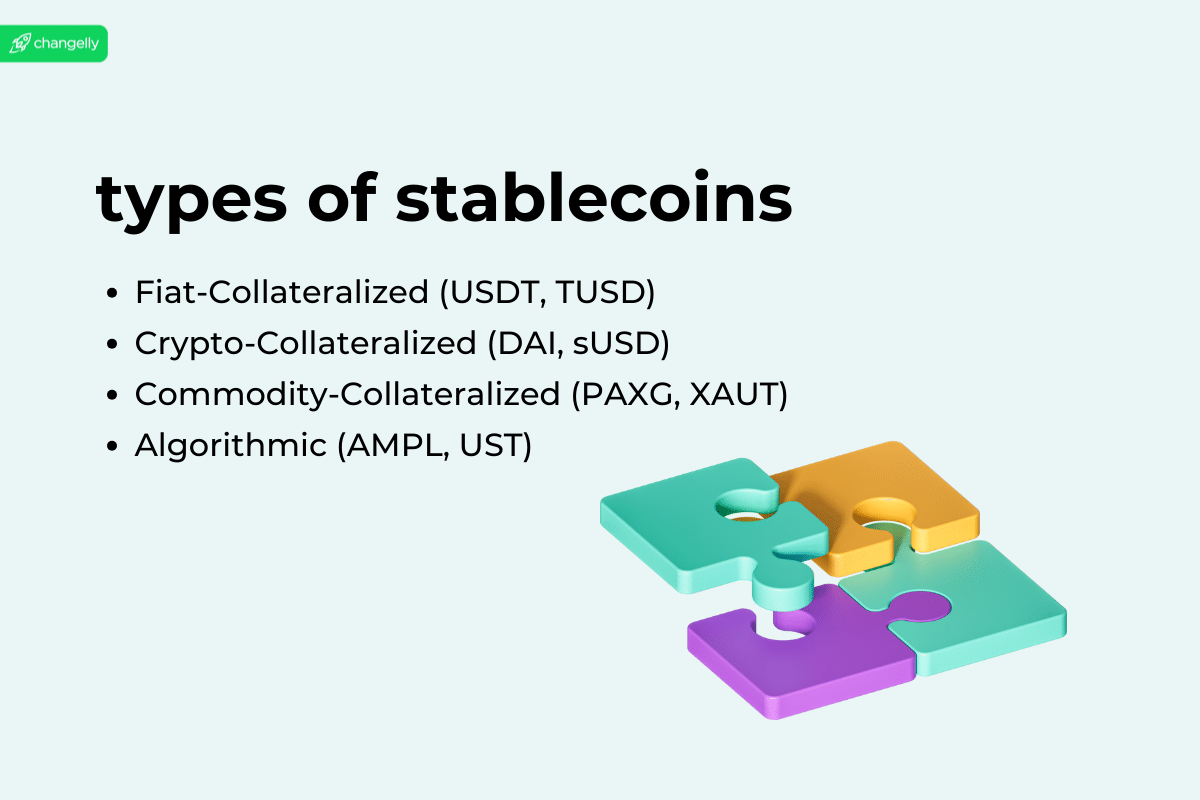Algorithmic Stablecoins Explained for Beginners
In crypto, stability can feel impossible. Prices swing, and volatility can rock the whole market. That’s why stablecoins exist: to give you dependable value in the eye of the storm.
Not all stablecoins maintain that stability the same way, though. Some are backed by fiat currency or other assets, while others—algorithmic stablecoins—try to do it with computer algorithms and market incentives alone. Let’s figure out how these coins work, why they matter, and what you should know before putting your trust in their code.
What Is an Algorithmic Stablecoin?
An algorithmic stablecoin is a cryptocurrency that uses computer algorithms and smart contracts to automatically adjust its token supply so the market price stays near a target value. It’s typically pegged to a fiat currency like the US dollar, but unlike fiat-backed stablecoins, it doesn’t hold that currency or other reserve assets in storage.
This design makes algorithmic stablecoins different from fiat-backed stablecoins (like USDC) or crypto-backed stablecoins (like DAI) which rely on collateral reserves. An algorithmic model removes the tangible asset requirement, aiming for stability through code and incentives alone.
Read more: Altcoins vs. Stablecoins: What’s the Difference?
Notable examples of algorithmic stablecoins include Ampleforth (AMPL), which uses a rebase model that changes supply across all wallets daily, TerraUSD (UST), developed by Terraform Labs under co-founder Do Kwon, which used a two-token model with its sister coin Luna on the Terra Classic blockchain, before it lost its peg, and Frax (FRAX), governed by Frax Protocol and operated by Frax Finance under founder Sam Kazemian, which initially combined partial collateral with algorithmic controls using its unique Algorithmic Market Operations (AMO) model. Each project takes a different approach to reaching the same goal: a stable value without full reserves. We’ll cover these coins and their models in the following sections.

How Algorithmic Stablecoins Work
Algorithmic stablecoins work by keeping their price near a target—usually $1—using algorithms to automatically increase or decrease the token supply based on market conditions. When the stablecoin’s price exceeds its intended peg, the algorithm mints new tokens to bring it down. When the price falls, it removes tokens from the circulating supply to push it back up. These rules are enforced by smart contracts on the blockchain.
The core principle is simple: change the supply to influence price. More tokens in circulation make each one worth less; fewer tokens make each one worth more. Because these changes happen automatically, algorithmic stablecoins eliminate the need for middlemen, or fiat currency/physical assets held in reserve. For everything to function, independent investors just need to perform price-stabilizing arbitrage, buying when prices are low and selling when prices are high.
In theory, this system creates a self-correcting mechanism that can maintain price stability indefinitely. In reality, though, its success hinges on continuous market demand and user confidence, both of which can disappear quickly under stress.
Different Types of Algorithmic Stablecoins
Most algorithmic stablecoins fall into three design camps. Here’s how each tries to stay pegged to the dollar, with code, incentives, and the occasional safety net.
Rebase Stablecoins (e.g., Ampleforth)
Rebase stablecoins adjust the number of tokens in circulation automatically, without user action. If the token trades above its target price, the protocol increases everyone’s balances proportionally, essentially “creating” more coins in every wallet to bring the price down. Conversely, if it trades below, balances shrink to reduce supply. This design aims to maintain the peg without collateral or manual minting. However, it can feel unpredictable for holders, since the amount of tokens in your wallet can change over time without your input.
Two-Token Models (e.g., TerraUSD)
Two-token models use a pair of digital assets: the stablecoin itself and a volatile partner token (these are sometimes also the project’s governance tokens). Traders mint stablecoins by burning the volatile token, and redeem them by swapping back. If price fluctuations cause the stablecoin’s price to rise above its peg, buying power shifts to minting more stablecoins, increasing supply until the price cools. If the price drops, the reverse happens, and stablecoins are burned in exchange for the volatile token to shrink supply. This design relies heavily on market incentives, and its stability is only as strong as demand for the paired token.
Hybrid Models (e.g., Frax)
Hybrid stablecoins, or fractional algorithmic stablecoins, combine algorithmic controls with partial collateral. Part of their value is backed by reserves, while the rest is stabilized by supply-adjustment mechanics similar to rebase or two-token systems. For example, when the price drifts above the peg, the protocol can mint more tokens, either by expanding balances or allowing swaps from other digital assets, all while still keeping the collateral as a safety net. This approach aims to combine the flexibility of algorithmic models with the security of collateral, offering a middle ground between the two extremes.
Become the smartest crypto enthusiast in the room
Get the top 50 crypto definitions you need to know in the industry for free

Benefits of Algorithmic Stablecoins
Algorithmic stablecoins have a number of advantages over other types of cryptocurrency. Let’s look at each in more detail.
- Capital Efficiency
This type of stablecoin doesn’t require locking up full collateral like fiat-backed or over-collateralized stablecoins. That means faster issuance and adaptability, which is an advantage for everyone. Frax (FRAX) is a standout here, as its fractional algorithmic stablecoin model initially clocked significant growth without having to tie up massive reserves. - Decentralization and Transparency
Because they operate through blockchain algorithms and open-source code, algorithmic stablecoins reduce reliance on centralized custodians. Instead, they operate under transparent, auditable code with no direct regulatory oversight. You don’t need a bank to vouch for reserves. Rebase coins like Ampleforth (AMPL) handle their supply logic on-chain, giving you visibility into how many tokens are in the circulating supply. - Scalability
Without constraints around real-world assets, these coins can scale quickly to meet rising demand. When demand increases, the protocol can mint more tokens automatically, without waiting for collateral deposits. This quick supply adjustment helps algorithmic stablecoins keep up with the pace of growing DeFi ecosystems and meet liquidity needs almost instantly. - Composability in DeFi
Algorithmic stablecoins plug smoothly into DeFi building blocks without dragging along collateral risk. They can flow into liquidity pools, yield farms, or lending platforms seamlessly. This makes them highly flexible tools for DeFi developers—but keep in mind, this benefit only pays off if the peg holds.
Risks and Problems of Algorithmic Stablecoins
If you’re looking for the most obvious example of things going wrong, look no further than the collapse of TerraUSD (UST). Before the crash, UST was a leading stablecoin, but in May 2022, its peg collapsed. The stablecoin’s value plunged as low as $0.10, dragging its sister token Luna from over $100 to virtually zero. It wiped out tens of billions in value in a single week.

The collapse laid bare several fundamental vulnerabilities of algorithmic stablecoins:
- Fragility Under Market Stress (Death Spiral)
The two-token model’s reliance on arbitrage and sentiment means it can unravel fast. If confidence drops—even slightly—or demand decreases suddenly, holders rush to exit. The resulting sell-off forces the system to mint vast quantities of the volatile token (like Luna), which then collapses, feeding into a downward spiral that’s almost impossible to stop. - Lack of a Redemption Safety Net
Traditional stablecoins often let you redeem 1 token for $1 of reserve. Algorithmic ones usually don’t, so if the peg breaks, there’s no anchored floor. You could be left holding something that has almost no value anymore. - User Behavior Makes or Breaks the System
Everything depends on traders responding rationally to profit signals. That works most of the time—until it doesn’t. Panic, redemptions, and sudden market shifts can all derail the mechanism. Market sentiment is a fragile thing. - History of Failures
UST isn’t the only high-profile algorithmic stablecoin failure. In 2021, Iron Finance’s partially algorithmic stablecoin IRON lost its peg after a run on its collateral token TITAN, causing TITAN’s price to crash from over $60 to near zero in less than 24 hours.
Another experiment, Fei (FEI), launched by Fei Labs and governed by Tribe DAO under founder Joey Santoro, introduced the Protocol Controlled Value (PCV) concept, where the protocol itself owns and manages the reserve assets rather than holding them in user-controlled vaults. Despite this innovative design, governance disputes and market challenges led to its wind-down in 2022.
Neutrino USD (USDN), issued via the Neutrino Protocol on the Waves blockchain founded by Sasha Ivanov, also lost its peg multiple times, highlighting risks in low-liquidity markets.
Other projects, like Empty Set Dollar (ESD) and Basis Cash, have also failed to hold their pegs, showing that total disaster isn’t exactly uncommon for this asset class.
Popular Algorithmic Stablecoins (Examples)
Here’s a quick look at key algorithmic stablecoins, and where they’re at today in the broader stablecoin market:
- TerraUSD (UST)
Once a top-three stablecoin, UST collapsed in May 2022. Today, it trades far below its peg as USTC and is widely regarded as a failed experiment. - Ampleforth (AMPL)
Still operating, AMPL continues using its rebase model—adjusting balances daily based on price. It remains niche, but is impressive in its functionality. - Frax (FRAX)
Initially a fractional algorithmic stablecoin with ~80% collateral, FRAX used a unique stabilization method called Algorithmic Market Operations (AMO)—allowing the protocol to directly interact with DeFi markets to influence its peg without changing collateral ratios. In early 2023, it transitioned to 100% collateralization after a community vote, favouring stability over algorithmic dynamics. - Basis Cash (BAC)
Now abandoned. The multi-token protocol Basis Cash never regained its peg after crashing, and now trades near zero value. - Empty Set Dollar (ESD) and Dynamic Set Dollar (DSD)
Both follow the seigniorage shares model, an approach where the protocol issues additional tokens during price increases, and shrinks the supply when price falls. While technically still active, neither maintains a reliable peg and both have lost prominence. - Celo Dollar (cUSD)
Celo Dollar (cUSD), stabilized through the Mento Protocol and operated by cLabs, Celo Foundation, and Mento Labs, continues to function with a mixed-collateral and market-operations model. - USDD (Tron’s algorithmic stablecoin)
USDD, managed by the TRON DAO Reserve on the Tron blockchain, is currently an over-collateralized stablecoin, with real crypto assets holding a 200%+ coverage ratio to reinforce confidence. It trades near $1 and has new utility features, including a “Smart Allocator” for on-chain yield and retail integrations across Southeast Asia.
Can Algorithmic Stablecoins Be Trusted?
Trust in this case does not mean guaranteed stability—here’s no design yet that has proven immune to market stress. But that doesn’t mean all algorithmic stablecoins are doomed from the start. Some, like Ampleforth (AMPL), still operate as designed, and Frax (FRAX) has shifted toward full collateralization to reduce risk, while USDD has added heavy over-collateralization to boost market confidence.
These adaptations show that trust can improve when protocols mix strong collateral with transparent governance. Still, given the history of high-profile failures, traders and investors treat them as higher-risk assets, often using them for short-term purposes rather than long-term stability. These coins rely on code, incentives, and liquidity conditions rather than holding equivalent reserves in a bank or blockchain wallets. As we’ve seen, when those incentives fail or liquidity dries up, the peg can collapse quickly, with no chance of recovery.

Are Algorithmic Stablecoins Legal?
The legality varies widely by country. In most places, there’s no single law targeting them specifically, but they fall under existing rules for digital assets, securities, or payment instruments. For example, in the United States, regulators like the SEC may classify algorithmic stablecoins as securities or commodities depending on their structure, and other governing bodies have their own designations. This means projects can often face multiple compliance requirements at once, even without an explicit law aimed at them.
In the European Union, the upcoming MiCA regulation will cover all stablecoins, including algorithmic designs, setting rules for transparency, reserves, and governance. Some countries, like South Korea, have openly stated they’ll scrutinize or ban high-risk designs after the TerraUSD collapse. In contrast, others—like Singapore—let them operate under licensing frameworks that require strong disclosure and safeguards. This patchwork means a project can be legal in one place, but restricted in another, making global adoption a regulatory balancing act for developers and issuers.
Are Algorithmic Stablecoins Safe to Use?
Only partially. While they aim to keep a stable value, algorithmic stablecoins usually have less or no collateral to make that happen, and rely instead on incentives and code, both of which can fail under stress. You can definitely use them, but they’re better suited for trading strategies or experimental DeFi than as a long-term “safe” store of value. Even well-designed systems are vulnerable to extreme market volatility, smart contract bugs, or poor governance.
Read more: What Is Volatility in Crypto?
History has shown that large-scale depegs can happen fast, wiping out vast sums in days, or even hours. Other projects, like Ampleforth, have maintained operations but still experience significant short-term swings that make them risky for everyday payments.
The Future of Algorithmic Stablecoins
Algorithmic stablecoins are unlikely to disappear. Developers continue to experiment with new designs aimed at solving the weaknesses that caused past failures, such as better collateral models, dynamic supply controls, and more transparent governance.
That said, the future depends heavily on regulation and public trust. Despite innovation in algorithmic models, the market still prefers fiat-backed stablecoins for their perceived reliability. But if algorithmic stablecoins can demonstrate consistent peg stability over time and comply with evolving legal frameworks, they could carve out a niche in DeFi and cross-border payments. Without clear safeguards, though, many will remain experimental assets rather than mainstream money.
Their future will come down to design resilience, community confidence, and the ability to learn from past mistakes.
Final Thoughts: Should You Use Algorithmic Stablecoins?
Algorithmic stablecoins offer innovation and potential scalability but carry not insignificant risk. As we’ve seen, design flaws, low liquidity, and market sentiment can quickly unravel even the largest projects. They may be worth exploring in small amounts if you know what you’re doing, and use them in contexts like DeFi experiments. But if your priority is preserving value, collateral-backed stablecoins remain the more reliable choice.
Approach them with caution, and as always: never risk more than you can afford to lose.
FAQ
What’s the difference between algorithmic stablecoins and regular stablecoins like USDT or USDC?
Regular stablecoins like USDT or USDC maintain their value by holding reserves—usually fiat currency or equivalent assets—equal to the number of coins issued. Algorithmic stablecoins don’t hold equivalent reserves. Instead, they rely on algorithms to automatically expand or shrink the supply based on current price, aiming to keep the token near its peg.
Can algorithmic stablecoins maintain a stable price over time?
Sometimes, but not always. If market demand and the underlying mechanism remain balanced, the peg can hold for long periods. However, history shows that loss of confidence or extreme price volatility can cause the peg to break—often permanently—because there’s no hard collateral backing it.
Should I invest in algorithmic stablecoins or just use them for trading?
They’re better suited for short-term trading or specific DeFi strategies rather than long-term holding. The higher risk of depegging means investors should be prepared for potential losses and avoid relying on them for stability over months or years.
Are algorithmic stablecoins decentralized or controlled by a company?
It depends on the project. Some are fully decentralized, with all supply adjustments handled by open-source smart contracts. Others are run or influenced by a core development team or company, which can introduce centralization in decision-making and governance.
Disclaimer: Please note that the contents of this article are not financial or investing advice. The information provided in this article is the author’s opinion only and should not be considered as offering trading or investing recommendations. We do not make any warranties about the completeness, reliability and accuracy of this information. The cryptocurrency market suffers from high volatility and occasional arbitrary movements. Any investor, trader, or regular crypto users should research multiple viewpoints and be familiar with all local regulations before committing to an investment.
The post Algorithmic Stablecoins Explained for Beginners appeared first on Cryptocurrency News & Trading Tips – Crypto Blog by Changelly.
Cryptocurrency News & Trading Tips – Crypto Blog by Changelly




















